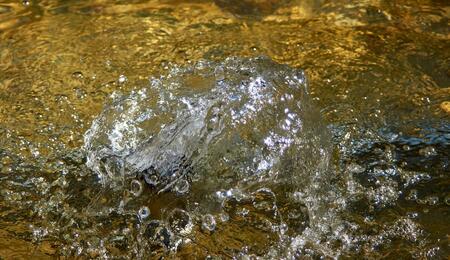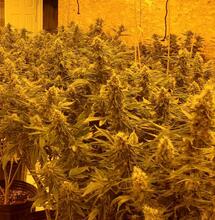Reverse Osmosis for Beginners

Growing plants is simple, right? Treat them nicely, give them enough light, water and food and the plants will reward you with some tasty buds. Filtered water is just for rich kids and soccer moms with too much time and money on their hands, not for plants. If water from the tap is good enough for us to drink, why spend money on filtering water for your plants?
Plenty of people give their garden plants tap water and they do just fine. However, if you are looking to push your girls to their absolute maximum and give them the best of everything, maybe you should take a look at reverse osmosis, or RO.
Think about it... you have spent your hard-earned cash on creating the perfect environment: a shiny digital ballast and state-of-the-art lamp and shade for the best quality light, intake and outtake fans connected to a fancy controller that regulates temperature and air flow in your room, an automated feeding system set to deliver expensive nutrients and additives at precisely the right time. Doesn't it make sense to mix your fancy nutrients with pure water, or is it just a gimmick?
Reverse osmosis systems are not a common sight, for example, in UK grow shops. In that area, many grow shop owners themselves may not be 100-percent sure about how they work or what they are used for, and for good reason: the British can drink their tap water. Unlike many countries across mainland Europe and the rest of the world, they have been blessed with an abundance of clean tap water that can be drunk without fear of shitting out all of their internal organs, or worse!
So, quite logically, if the water is safe for them, it is safe for their plants.
This is in stark contrast to the United States, where the tap water is often - to put it bluntly - terrible! In many American cities the tap water is, at best, impure - at worst, completely undrinkable. Therefore, if you venture into any grow shop in the United States, you are very likely to see a range of filtration and RO systems that have been created specifically for hydroponic growers.
But why exactly would you want, or need, to remove the impurities from the water that you give to your plants? Well, there are several reasons. The first (and probably the most important) is pretty simple: to get the most out of your expensive nutrients.
Read any decent nutrient manufacturer's feed chart and you will notice that they recommend adding nutrient to your water until a desired strength is reached - measured in either parts-per-million (PPM) or electrical conductivity (EC). For example, feed young plants a nutrient solution of 1.2 EC. That sounds simple enough - just use an EC meter to measure your solution until you reach the desired strength. However, this recommended EC of 1.2 assumes a starting EC value of zero, and your tap water already has an EC value to start with.
Your tap water will naturally contain elements such as calcium, magnesium and sodium. The 'harder' (more alkaline) your water is, the more of these compounds it will contain. Tap water differs depending upon the area in which you live; different areas have different compositions and may contain additional elements such as iron, potassium, sulfur, nitrates and trace elements such as boron, copper, manganese and zinc.
You may have a starting EC anywhere in the range of 0.2 to 0.8, or higher; the key thing is that you do not know the composition and the ratio of these elements. Therefore, the balanced elements in your expensive nutrients can become unbalanced when added to tap water, causing deficiencies or nutrient lock-out and restricting the growth of your plants.
RO water provides you with a 'clean sheet', a pure and neutral base to which you can add your nutrients. So you can be assured that your plants are receiving the correct elements in the optimum balance. In addition, complete changes of your nutrient reservoir are needed less frequently, because you can be confident that the starting EC level was completely balanced.
RO provides a consistent base-supply of water; you can be assured time after time that your water's EC will not fluctuate and so can get into a routine of setting nutrient strength and pH. This is especially important for growers in regions that are fed by more than one water supply; for example, in some parts of the world, homes are fed by two or three different reservoirs and can receive 'soft' water in the mornings and 'hard' water in the afternoons! This makes it almost impossible to set an effective feeding schedule, but an RO system will solve this dilemma.
Removing alkalinity from the water will prevent build-ups of mineral salts in irrigation pipes, drippers and sprinklers. Growers in very 'hard'-water areas will no longer have to check their irrigation systems for blockages or add cleaning agents to their reservoirs in order to keep things running smoothly.
Purified water is also very handy for growers who regularly use humidifiers in their rooms, as it stops the build-up of minerals in the form of white dust on their plants and grow equipment, therefore prolonging the life of their carbon filters and grow lights.
Finally - and perhaps most unexpectedly - growers who use organic nutrients and additives, or brew their own compost tea, will also find filtered water produces better results. This is because tap water commonly contains chlorine - a cleansing agent - in either the form of chlorine or combined with ammonia to form chloramine. It is widely accepted that letting tap water sit for around twenty-four hours allows the chlorine to evaporate off, but that is not the case with chloramine - which would take months to completely evaporate. Growers who add beneficial bacteria and micro-organisms, such as Trichoderma and mycorrhiza, may find the effects of these microbes are neutralized when added to unfiltered tap water containing chloramine.
Running tap water through a granulated carbon filter - usually the second-stage filter in an RO system - effectively removes both the chlorine and chloramine present, allowing beneficial microbial life to flourish.
So, how does a reverse osmosis system work? It involves forcing a solution containing a mineral content through a very fine, semi-permeable membrane (think of it as an ultra-fine filter) that allows solution (water) through, but prevents any larger molecules from passing - therefore purifying the solution of all dissolved minerals and producing pure water. One of the most widely-used applications for reverse osmosis is to produce pure drinking water from sea water, by filtering out all salts and other dissolved substances that are present.
RO systems used in hydroponic gardening usually consist of three filtering stages:
Stage 1 - Sediment Filter: Removes any fine particles that could damage the osmosis membrane.
Stage 2 - Granulated Carbon Filter: Removes all chlorine, chloramine and organic elements.
Stage 3 - Semi-Permeable
Membrane: Removes the vast majority of dissolved minerals, leaving you with virtually pure water.
Most RO systems are fairly simple to install, attaching directly to the copper pipe of your water supply. The back pressure of your mains forces the water through the filters. A variety of systems are available starting at a 'hobby' size - producing a maximum of around 60 gallons per day - up to huge industrial units, with an output of hundreds of gallons.
How to Determine the Need to Use Reverse Osmosis:
The first step is to test the EC of your tap water, using a standard EC pen, sampling it at various times throughout the day. If different time periods provide vastly different readings then your mains water supply may be coming from different sources, making it difficult to deliver a consistent nutrient program. An RO system would help.
If you use a hydroponic system or just a simple irrigation setup and notice a build-up of mineral salts in the pipework, drippers or pump, then an RO system will help to prevent this.
If the background EC is very high - over 0.8 - then RO may be a worthwhile investment. A reading this high indicates a high level of compounds present, which have the potential to unbalance the nutrient solution that you feed to your plants.
It is worth bearing in mind that an EC pen will not provide you with any information on the actual mineral composition of your water. For that, it may be helpful to speak to your local grow shop, garden supply center or aquatic specialist (fish/pond stores) to see if they can supply a testing kit, or search online for a kit.
Downsides to RO
Every positive carries a negative and RO systems are no exception. Firstly, they are relatively wasteful in the sense that they produce waste water in the approximate ratio of one-to-three. So, for every gallon of purified water produced, you get three gallons of waste water. If the water supply is particularly hard or mains pressure is low, even more waste water is produced. This means that a hobby RO system would require eighty gallons of tap water to produce twenty gallons of pure water, wasting sixty gallons of water. For any grower on a water meter, this would probably rule out a purchase immediately!
The units can be relatively inexpensive to buy and maintain - for example, the smaller hobby versions cost around $150 or less - however, some growers promote caution with 'you get what you pay for' stories about purchasing the lower-priced systems. The carbon filter and sediment filter need to be replaced every three or four months, but the semi-permeable membrane will last for around two years. Replacement parts should be factored into the total cost for budgeting purposes.
One interesting downside of RO systems is that, as well as removing all of the minerals that unbalance your nutrient solution, they also remove the minerals that are helpful to your plants. Bicarbonates and carbonates present in tap water create an alkalinity that helps to buffer the pH of the water. These compounds help to raise the pH and neutralize the effects of any acids that are added to water - including those present in your nutrients, and also the ones put out by your plants as waste. By completely removing those with an RO system, the pH will be rendered unstable. To counteract this, once the water has been purified by the system, a small amount of tap water or baking soda needs to be added, to slightly increase the EC and provide the buffer.
Calcium and magnesium - both essential to plant development - will also be removed by the RO system and may need to be supplemented along with your base nutrient. This is because many of the nutrient companies formulate their recipe to cater for 'hard' water - already containing relatively high levels of calcium and magnesium - and therefore reduce the amount of these elements in their recipes, in order to prevent overfeeding.
Using these nutrients in RO purified water can lead to calcium and magnesium deficiencies, which can lead to serious problems in the flowering stage; when the plant's uptake of phosphorus and potassium rises, so does its need for magnesium and calcium. If these elements are not present, then your expensive PK booster will basically stop working, because your plants will not be able to take it in.
Adding a high quality calcium and magnesium supplement to your RO water before adding base nutrients will prevent these problems from occurring, ensuring your plants remain healthy and green through to harvest.
RO water is more than just a gimmick. If your plants suffer from regular nutrient imbalance or you grow in a 'hard' water area, it may be a necessity; if you are looking for a shiny new toy for your grow room, it is well worth an investment.
Happy growing!



